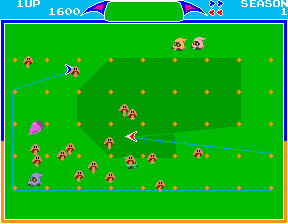 The Game: In a peaceful garden dotted with a gridwork of posts, the player must simultaneously move two pointers, connected to each other by a tenuous string, to trap mobile mushrooms and pointy-hatted garden gnomes. If either pointer comes into contact with a gnome, a life is lost (and, for the record, it’s not the gnome’s life). A scissor-like critter occasionally crosses the screen, and he’s capable of severing the string; a new one instantly forms between the two pointers, but any progress that was made in creating a trap with the string is lost. When all of the creatures invading the player’s garden are trapped, the game begins again at a higher difficulty level; if all of the player’s lives are lost, or time runs out, the game is over. (Namco, 1983)
The Game: In a peaceful garden dotted with a gridwork of posts, the player must simultaneously move two pointers, connected to each other by a tenuous string, to trap mobile mushrooms and pointy-hatted garden gnomes. If either pointer comes into contact with a gnome, a life is lost (and, for the record, it’s not the gnome’s life). A scissor-like critter occasionally crosses the screen, and he’s capable of severing the string; a new one instantly forms between the two pointers, but any progress that was made in creating a trap with the string is lost. When all of the creatures invading the player’s garden are trapped, the game begins again at a higher difficulty level; if all of the player’s lives are lost, or time runs out, the game is over. (Namco, 1983)
Memories: This interesting obscurity from Namco wouldn’t appear to have much historical significance, and it made little or no headway beyond Japan’s borders. What makes Libble Rabble at least a little bit significant is that it was the last arcade game design hurrah of Toru Iwitani, the creator of Namco’s global megahit Pac-Man.
 After Libble Rabble debuted to little fanfare, Iwitani was moved up to a supervisory position within Namco. In a way, it was the safest move possible: there wouldn’t be another Libble Rabble, but it kept him within the company just in case his next idea was the next Pac-Man. At last report, he’s still working for Namco to this day.
After Libble Rabble debuted to little fanfare, Iwitani was moved up to a supervisory position within Namco. In a way, it was the safest move possible: there wouldn’t be another Libble Rabble, but it kept him within the company just in case his next idea was the next Pac-Man. At last report, he’s still working for Namco to this day.
As for Libble Rabble itself, it’s a bit like Qix meets Pepper II, with the control system of Robotron. Why and how it didn’t become more popular is  probably just a matter of timing and tastes. It’s an amusing enough game, but even now it doesn’t seem to have the same addictive replay value of Pac-Man or the rest of his family tree. Definitely an acquired taste.
probably just a matter of timing and tastes. It’s an amusing enough game, but even now it doesn’t seem to have the same addictive replay value of Pac-Man or the rest of his family tree. Definitely an acquired taste.

